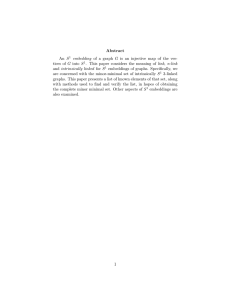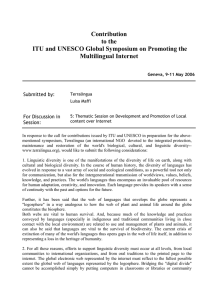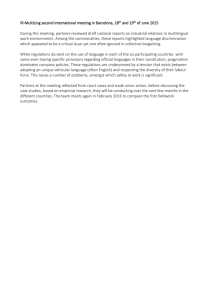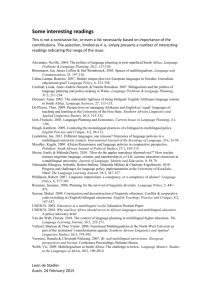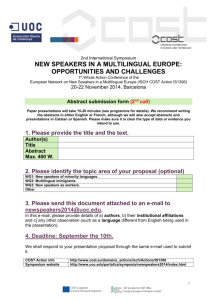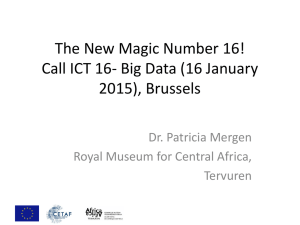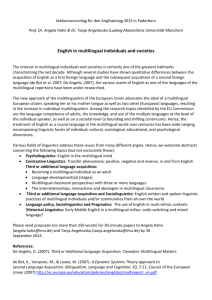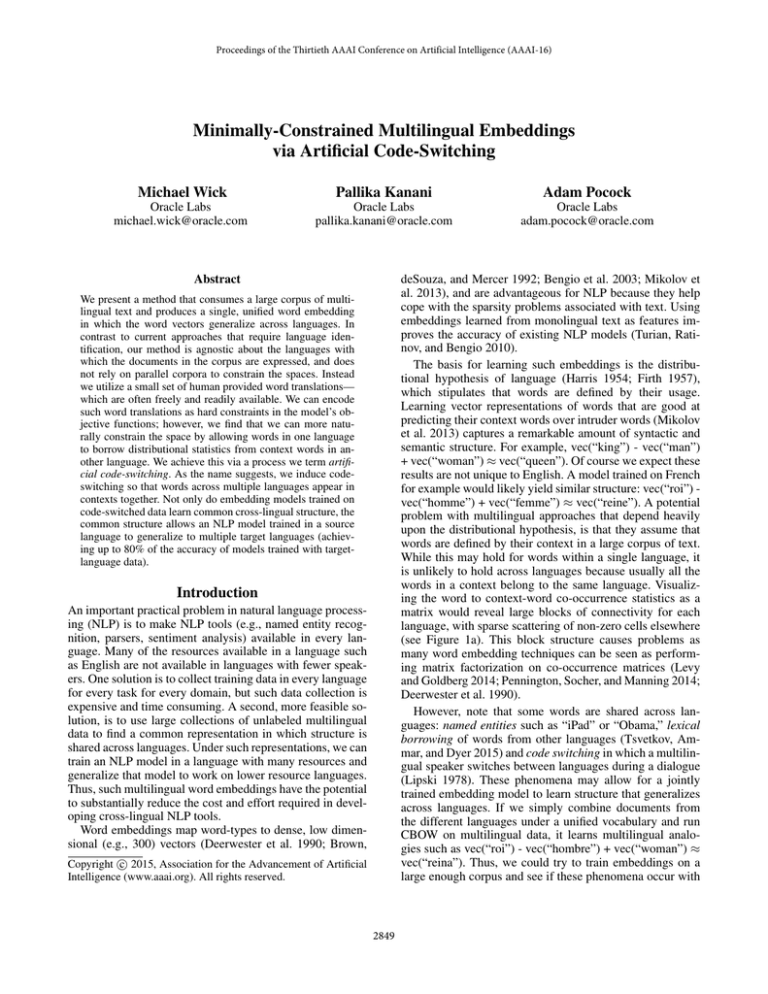
Proceedings of the Thirtieth AAAI Conference on Artificial Intelligence (AAAI-16)
Minimally-Constrained Multilingual Embeddings
via Artificial Code-Switching
Michael Wick
Pallika Kanani
Adam Pocock
Oracle Labs
michael.wick@oracle.com
Oracle Labs
pallika.kanani@oracle.com
Oracle Labs
adam.pocock@oracle.com
deSouza, and Mercer 1992; Bengio et al. 2003; Mikolov et
al. 2013), and are advantageous for NLP because they help
cope with the sparsity problems associated with text. Using
embeddings learned from monolingual text as features improves the accuracy of existing NLP models (Turian, Ratinov, and Bengio 2010).
The basis for learning such embeddings is the distributional hypothesis of language (Harris 1954; Firth 1957),
which stipulates that words are defined by their usage.
Learning vector representations of words that are good at
predicting their context words over intruder words (Mikolov
et al. 2013) captures a remarkable amount of syntactic and
semantic structure. For example, vec(“king”) - vec(“man”)
+ vec(“woman”) ≈ vec(“queen”). Of course we expect these
results are not unique to English. A model trained on French
for example would likely yield similar structure: vec(“roi”) vec(“homme”) + vec(“femme”) ≈ vec(“reine”). A potential
problem with multilingual approaches that depend heavily
upon the distributional hypothesis, is that they assume that
words are defined by their context in a large corpus of text.
While this may hold for words within a single language, it
is unlikely to hold across languages because usually all the
words in a context belong to the same language. Visualizing the word to context-word co-occurrence statistics as a
matrix would reveal large blocks of connectivity for each
language, with sparse scattering of non-zero cells elsewhere
(see Figure 1a). This block structure causes problems as
many word embedding techniques can be seen as performing matrix factorization on co-occurrence matrices (Levy
and Goldberg 2014; Pennington, Socher, and Manning 2014;
Deerwester et al. 1990).
However, note that some words are shared across languages: named entities such as “iPad” or “Obama,” lexical
borrowing of words from other languages (Tsvetkov, Ammar, and Dyer 2015) and code switching in which a multilingual speaker switches between languages during a dialogue
(Lipski 1978). These phenomena may allow for a jointly
trained embedding model to learn structure that generalizes
across languages. If we simply combine documents from
the different languages under a unified vocabulary and run
CBOW on multilingual data, it learns multilingual analogies such as vec(“roi”) - vec(“hombre”) + vec(“woman”) ≈
vec(“reina”). Thus, we could try to train embeddings on a
large enough corpus and see if these phenomena occur with
Abstract
We present a method that consumes a large corpus of multilingual text and produces a single, unified word embedding
in which the word vectors generalize across languages. In
contrast to current approaches that require language identification, our method is agnostic about the languages with
which the documents in the corpus are expressed, and does
not rely on parallel corpora to constrain the spaces. Instead
we utilize a small set of human provided word translations—
which are often freely and readily available. We can encode
such word translations as hard constraints in the model’s objective functions; however, we find that we can more naturally constrain the space by allowing words in one language
to borrow distributional statistics from context words in another language. We achieve this via a process we term artificial code-switching. As the name suggests, we induce codeswitching so that words across multiple languages appear in
contexts together. Not only do embedding models trained on
code-switched data learn common cross-lingual structure, the
common structure allows an NLP model trained in a source
language to generalize to multiple target languages (achieving up to 80% of the accuracy of models trained with targetlanguage data).
Introduction
An important practical problem in natural language processing (NLP) is to make NLP tools (e.g., named entity recognition, parsers, sentiment analysis) available in every language. Many of the resources available in a language such
as English are not available in languages with fewer speakers. One solution is to collect training data in every language
for every task for every domain, but such data collection is
expensive and time consuming. A second, more feasible solution, is to use large collections of unlabeled multilingual
data to find a common representation in which structure is
shared across languages. Under such representations, we can
train an NLP model in a language with many resources and
generalize that model to work on lower resource languages.
Thus, such multilingual word embeddings have the potential
to substantially reduce the cost and effort required in developing cross-lingual NLP tools.
Word embeddings map word-types to dense, low dimensional (e.g., 300) vectors (Deerwester et al. 1990; Brown,
c 2015, Association for the Advancement of Artificial
Copyright Intelligence (www.aaai.org). All rights reserved.
2849
(a) Bilingal co-oc matrix
document is known, and requires parallel corpora. At a high
level, most approaches employ such aligned translated documents to constrain two monolingual models so that they
agree upon a common bilingual representation. For example, by constraining the representations of recurrent neural networks (Sutskever, Vinyals, and Le 2014), multilayer
perceptrons (Gao et al. 2014), regularized auto-encoders
(Sarath Chandar et al. 2014), multi-task learners (Klementiev, Titov, and Bhattarai 2012), and other models (Hermann
and Blunsom 2013) in this way. Unfortunately, in many
cases, finding a sufficiently large parallel corpus of paired
documents in the source and target languages is difficult, especially for lower resource languages.
Alternatively, canonical correlation analysis (CCA)
(Faruqui and Dyer 2014) and deep CCA (Lu et al. 2015) are
suitable for mapping word vectors into a common bilingual
space. Although these approaches currently employ parallel corpora, they might be able to employ dictionaries instead because they only require alignments across vocabulary words (word-types). However, we do not yet know
whether a small handful of word translations is sufficient
for CCA, and even so, these approaches would still require
language identification when deployed in the wild in order
to determine the correct mapping to apply. Furthermore, a
potential problem with approaches that apply a global transformation is that the transformation might not be equally appropriate for every word in the vocabulary since it is likely
that the monolingual embedding spaces of the two languages
are partially (but unevenly) aligned (for example, due to natural phenomena such as lexical borrowing, code-switching
and pervasiveness of named entities).
There has also been recent work in relaxing the requirement of aligned parallel corpora. For example, sentencelevel alignment is easier to obtain than word level alignment allowing a wider range of corpora to be used. Such
sentence-level alignment are naturally captured via autoencoders (Sarath Chandar et al. 2014) or other models (Hermann and Blunsom 2013) by learning a mapping from the
source sentence bag of words (BoW) to a target sentence
BoW. Concurrent to our work, Barista is one of the few approaches to eliminate parallel corpora entirely (Gouws and
Søgaard 2015). Although justified differently, Barista and artificial code switching both employ dictionaries to transform
the data for learning language invariance. Barista is defined
for and evaluated in the bilingual setting in which it works
remarkably well, allowing an NLP system (a part of speech
tagger) trained in one language to generalize to another.
In contrast to the aforementioned approaches which are
predominantly bilingual, we combine as many corpora from
as many languages as possible into the same embedding
space. Note that in many cases, moving from the bilingual to
multilingual setting is difficult because the number of constraints scales quadratically with the number of languages.
Combining many languages together is not only more convenient (than managing many bilingual pairs), but has the
potential to learn better quality embeddings. For example,
on a document similarity task, recent work demonstrates that
combining similarity scores across four languages results in
a more accurate similarity measure than those based on a
(b) ACS co-oc matrix.
Figure 1: A cartoon of a word to context-word co-occurrence
matrix for a bilingual corpus (English and French). The matrix is essentially block diagonal, but each block is fairly
sparse as it represents the co-occurrence of words within the
language. The cartoon on the right shows the matrix after
artificial code-switching is applied.
sufficient frequency to learn a good multilingual embedding.
Though we expect to do even better if we modify the model
or data to more directly capture multilingual structure.
In this paper, we study two ways of improving multilingual embeddings via human provided dictionaries that translate a small subset of vocabulary words across multiple languages. In our initial approach, we augment the underlying
embedding method with a set of constraints derived from
the word translations. The constraints force dictionary words
to have similar magnitudes and angles between them. However, we find that balancing the constraints with the original objective can be challenging. Thus, in our second approach, we transform the data using a process we term artificial code switching (ACS). In much the same way that
machine vision practitioners apply affine transformations to
their training data to learn invariance to rotation and scale,
we apply ACS to our training data to learn invariance to language. The ACS transformation employs the translation dictionaries to replace some of the words in the text with their
(possibly rough) translation from another language. Effectively, ACS fills in more cells of the co-occurrence matrix
(Figure 1b) making the matrix less block diagonal, and thus
ripe for learning multilingual representations.
Our methods improve the quality of multilingual embeddings over a system that relies upon natural cross lingual
co-occurrences alone. Further, we provide multilingual word
analogy data on which we find that combining multiple languages into a single space enables lower resource languages
to benefit from the massive amount of data available in
higher resource languages. We determine that ACS in particular learns the best multilingual word embeddings, achieving more than 50% accuracy on bilingual word analogies.
Finally, we find that our multilingual embeddings allow us
to build sentiment models in languages without training data
by training models on English and using the embedding to
generalize the information to other languages.
Related Work
Most work on learning multilingual word representations focuses on bilingual data, assumes that the language of each
2850
single language (Hassan, Banea, and Mihalcea 2012).
Multilingual Embeddings
A key motivation for this work is to make progress towards the goal of building multilingual NLP systems using a three step process: (1) Train a multilingual embedding on a large, unlabeled corpus of multilingual documents
that span the desired languages. (2) Train NLP models on
all available training data, using word embeddings as features. (3) Apply the trained model on data from any of the
target languages and achieve accuracy comparable to having
in-language training data.
Achieving this goal depends on several key hypotheses:
(H1) word embeddings provide sufficient information for
training accurate NLP models; (H2) monolingual word embeddings in different languages have similar structure; (H3)
a small set of constraints is sufficient for learning this shared
structure (H4) the shared structure is sufficient for generalizing NLP models from one language to another.
We expect the extent to which these hypotheses hold depends heavily on the model and task. Further, we expect that
the hypotheses themselves are a simplification as we cannot expect simple embedding models to fully capture the
richness of language. Three areas which will cause problems with our approach are: linguistic complexities (e.g.,
varying levels of inflection across languages), word sense
disambiguation across languages (e.g., “car” has different
meanings in English and Spanish), and cultural diversity
(e.g., Spanish has different words for “aunt” depending on
whether it is the maternal or paternal aunt). Despite these
challenges, in the experiments section we provide initial evidence in support of these hypotheses.
Figure 2: Different updates on word-context pairs.
sisting of a matrix in which each row is a word vector. Suppose the underlying embedding model is trained using the
following objective function:
(1)
M = argmaxW f (D; W )
For example, the SkipGram/CBOW objective function
(Levy and Goldberg 2014), with
negative sampling,
T
is approximately: f (D; W ) =
w,c∈D σ(Wx Vc ) −
1
T
w,c∈D̂ σ(Ww Vc ) where σ(x) = 1+e−x is the logistic function, D̂ is the negative dataset and V is the output
weights. In SkipGram the context is a single word, whereas
in CBOW it is the average vector over the context window.
Figure 2 shows different kinds of updates that can be performed on a multilingual set of words and contexts. We show
the CBOW update as an unbroken black arrow. The update
performed by CBOW moves the context closer to the word,
and the word closer to the context.
We now present two approaches for learning multilingual
embeddings. In the first approach we directly encode the dictionaries as constraints in the underlying word embedding
objective function. In the second approach, we use the dictionaries to transform the data in a way that induces code
switching between all the languages.
Problem Setting
Constraint-based Multilingual Embeddings
Suppose we have M languages Lm with corresponding vocabularies Vm , then V = ∪M
m=1 Vm is the vocabulary of all
the languages. We have a large corpus of multilingual text
D with documents Di ∈ D comprised of word sequences
w1 , · · · , wni where each wj ∈ V . We also have a small set
of human-provided concept dictionaries C that link words
across languages. A concept dictionary C is a set of concepts where each concept Ci ∈ C is a set of words that all
have similar meaning (e.g., a concept set containing “red”,
“rouge” and “rojo”). Note that we do not necessarily know
the language for any given word or document.
Our task is to learn an embedding model M : V → Rk
that maps each word type to a k-dimensional vector such
that the vectors capture syntactic and semantic relations between words in a way that generalizes across the languages.
We investigate a solution space that is modular in the sense
that the multilingual approaches are compatible with many
underlying (monolingual) embedding methods. In this way,
it is easy to implement the techniques on top of existing
embedding implementations such as LSA, RBMs, CBOW,
SkipGram, GloVe, or LDA.
We begin with a brief description of the area of word embeddings to introduce the necessary terms. Let W be the
weights of some underlying embedding model, usually con-
We modify the original word embedding objective function
(Equation 1) with a constraint term g(C; W ) that encourages
the satisfaction of the cross-lingual constraints:
(2)
f (D, C; W ) = f (D; W ) + g(C; W )
There are many possible ways of defining g, but defining it
in a way that balances the dictionary concepts with the data
is surprisingly difficult. One possibility is to represent each
concept set as a vector and then update words to increase
their probability under both their context-word and conceptset vectors. However, we find that this approach does not
work in practice because the constraints imposed by the data
(context) dominate the constraints imposed by the concept
sets. Instead, we employ a more aggressive form of constraints that encourage words in the same concept set to have
small angles between and similar magnitudes to each other:
σ(cos(Wi , Wj ))
(3)
g(C; W ) = −
c∈C wi =wj ∈c
where C(w) = {c | c ∈ C ∧ w ∈ c} are concepts containing
w. In Figure 2 the constraint updates are shown as a blue
dotted line, representing the constraints pulling the vectors
for “rouge” and “red” closer together. As these two words
are pulled together the context words also move closer.
2851
Artificial Code-Switching
Remark: we can more precisely characterize the underlying objective function of ACS with SkipGram. To briefly
sketch this, note that SkipGram can be seen as factorizing
the shifted word to context pointwise mutual information
(PMI) matrix, which depends only upon unigram and wordpair probabilities. Thus, we can combine our definition for
q(w |w) with the unigram and word-pair probabilities of the
original data D to express the corresponding quantities for
the ACS data D from which we can express the cells of the
matrix ACS produces. We then compare matrix cells corresponding to word-pairs within a language with word-pairs
across languages, and see that code-switching parameter α
balances how mass is distributed across these two cell types.
Code-switching is the process in which a speaker of multiple languages switches between those languages in discourse. Consider the utterance “pizza khaneka mood nahi”
which translates to “not in the mood to eat pizza.” The Hindi
verb “khaneka” which means “to eat” and the English noun
“pizza” are able to share distributional information via the
code-switched utterance. As we can see, code-switching allows the distributional meaning of a word in one language
to borrow from context in another language, thus providing
a rich base from which to learn window-based embeddings.
Unfortunately, in written text—and especially concerning certain European languages such as French—codeswitching is an infrequent event. Thus, one approach would
be to use a classifier to identify instances of code-switching
and treat such contexts in a special way (e.g., by giving
higher weight to the updates from the code-switched data).
However, as illustrated by the example utterance (which
contains two transliterated Hindi words and two English
words), the problem of language identification is non-trivial,
especially for social media (e.g., tweets). Also, it is not
clear that sufficient natural code-switching occurs in large
datasets such as Wikipedia.
Instead, we use our dictionaries to artificially induce extra code-switching in the input data. This process, which
we term artificial code-switching (ACS), fills in unobserved
cells in the word to context-word co-occurrence matrix (see
Figure 1b). This extra knowledge is analogous to having extra recommendations in a recommender system (i.e., recommendations that a word in one language could be substituted
for a word in another language). An interesting question is
how to fill the cells of this matrix in a way that most naturally
causes the learning of shared structure in the multilingual
space. Ideally, in order to respect the distributional hypothesis, we want the co-occurrence statistics between words of
different languages to resemble the co-occurrence statistics
of words within a language, while at the same time, preserving the co-occurence statistics of words within a language.
A simple way of accomplishing this is to fill in the matrix by
randomly replacing a word in one language with its translation in another. In this way, co-occurrence “mass” from the
monolingual blocks is shared across languages.
Specifically, we generate a new code-switched corpus D
by transforming each word wi ∈ D into a new word wi with
a transformation distribution q(wi |wi ) defined as follows.
First, we draw a variable s ∼ Bernoulli(α). If s = true
then we code-switch and sample a new word wi . To generate
wi we sample a concept c from C(wi ) then we sample a
word wi from c. If s = f alse then we do not code switch.
Looking at Figure 2 again, we can see that the codeswitching update moves the English word “red” closer to the
French context for the word “rouge” and vice versa. This
does not directly affect the relationship between “red” and
“rouge” but over repeated updates it enforces a relaxed form
of the constraint update given in the previous section.
Of course, more complex models of code-switching are
possible, but our goal is not to model the phenomena of
code-switching; rather, we are interested in exploiting it to
introduce multilingual structure in our embedding space.
Experiments
The purpose of our experiments is to assess the quality and
utility of the multilingual embedding spaces. The first set of
experiments measures the former, and the second set measure the latter on the task of sentiment analysis. We select five languages to represent various levels of resourceavailability, as reflected by the number of Wikipedia pages.
English has almost five million pages in Wikipedia, French,
German and Spanish each have over a million, whereas,
Bokmål has over 100,000 articles. See Table 1 for a list of
languages. We also considered languages with even fewer
Wikipedia pages, but found a large proportion of the pages
to be stubs, and hence less useful.
Systems
Each system employs CBOW as the underlying model f .
The multilingual embedding models also employ a set of
human provided concept dictionaries C that translate words
with similar meaning from one language to another. Such
dictionaries are readily available, and for the purpose of
these experiments we use OmegaWiki,1 a community based
effort to provide definitions and translations for every language in the world. Systems include:
• Monolingual - A baseline system in which separate embeddings are trained for each language on monolingual
data with CBOW.
• CBOW No constraints (no const) - A baseline system in
which we train CBOW on a multilingual corpus.
• CBOW With constraints (with const) - The method described by setting g to Equation 3. After each CBOW update, we perform updates to satisfy g on words in the context for which we have a constraint.
• Artificial code switching (ACS) - The artificial code
switching approach in which we use the concept sets in
OmegaWiki to perform the word substitutions. We set the
parameter α = 0.25.2
The data in our experiments comprises interleaved documents from the various mono-lingual Wikipedias: bilingual experiments involve Wikipedia documents in two languages; multilingual experiments use Wikipedia documents
1
http://www.omegawiki.org
α = 0.25 is our initial guess for the parameter; we find on
development data that the method is robust to the setting of α.
2
2852
Language
English (en)
French (fr)
German (de)
Spanish (es)
Bokmål (no)
Embedding Data
#Docs (x106 ) #Concepts
4.87
8821
1.62
7408
1.82
8258
1.18
6501
0.41
5336
Sentiment Data
#Train
#Test
%Tw
24960
6393
36.0%
14284
3081
36.0
12247
2596
25.5
16506 59529 84.7
1225
1000
0.00
Target Language Baseline
TwA% TotA%
63.8%
68.4%
69.9
74.9
70.2
74.9
64.4
64.2
72.9
Table 1: Datasets. Sentiment accuracy on just twitter documents (TwA) and all documents (TotA).
Method
no const
with const
ACS
Monolingual
Word-pair cos.
0.286
0.422
0.439
-0.015
En W. Analogy
77.5%
52.8
66.9
81.1
Fr W. Analogy
47.8%
40.4
53.3
45.2
Mixed En+Fr W. Analogy
39.3%
43.6
52.6
NA
Table 2: Comparison of multilingual embeddings.
from all five languages. In all experiments, we use the same
CBOW parameters (2 iterations, 300 dimensions, learning
rate 0.05, filter words occurring fewer than 10 times).
ACS achieving the most improvement. Furthermore, ACS
performs substantially better on the mixed (En+Fr) word
analogies than the other systems. The results indicate that
ACS learns common multilingual structure.
We also measure accuracy on English and French monolingual word analogies. On English, a high resource language, the multilingual information hurts performance.
However, for French—which has an order of magnitude
fewer tokens than English—the multilingual information
improves the quality of the embedding, especially with ACS,
which again performs best. We believe that the reduction of
English performance is because each English word is trained
less in the ACS system, thus we expect more training iterations will compensate for the drop in English performance.
We conclude that the shared structure allows a low resource
language to benefit from a high resource language (though,
at some cost to the high resource language when using the
same number of iterations).
Together, these results provide some evidence for the hypotheses and assumptions stated earlier. In particular, that a
substantial amount of structure is shared across languages,
and that artificial code switching is able to capture such
structure. One reason ACS is so effective is that it is able
to overrule concept-based constraints when they contradict
meaning derived naturally from the data.
Evaluation of embedding space
In this experiment we evaluate the quality of the joint multilingual embedding space. We assess two aspects of the
spaces. First, the amount of structure shared across languages. Second, as the number of languages increases in
the shared space, how does the quality of the individual language’s representation change in this space.
For the latter aspect, we examine the accuracy of
multilingual embeddings on the word analogy task
(Mikolov et al. 2013). An example analogy question is
man:king::woman:?. The embedding makes a prediction via
king − man + woman and if (and only if) queen is one of
the top five most similar words to the resulting vector then
the model is credited with getting the analogy correct. The
original dataset contains analogies in English, but we translate them into French.
For evaluating the former aspect, first, we create a mixed
bilingual (En+Fr) analogy tasks by mixing words from
the monolingual analogies, e.g., homme:roi::woman:queen.
Second, we split the OmegaWiki concepts into 50/50 training/testing sets. We train the embedding models using half
the concepts, and use the other half for evaluating the quality
of the embedding (via the average cosine similarity of words
that appear in the same concept).
We present the evaluations in Table 2. All models are
trained on the combination of English, French, Spanish, German, and Bokmål, but the monolingual models are trained
on each language independently. First, observe that CBOW
alone (with no constraints) learns a considerable amount of
cross-lingual word similarity (0.286 cosine similarity). This
is likely due to the phenomena mentioned in the introduction
(e.g., lexical borrowing), and is notable because multilingual word-vectors from independently trained embeddings
should be orthogonal (as verified by last row of the table).
Both multilingual embedding techniques substantially improve the cosine similarity over multilingual CBOW, with
Evaluation on sentiment
The purpose of this experiment is to test if our multilingual
embeddings allow us to train an NLP model on a high resource language (English), and then evaluate it on languages
for which no training data exists. We do not expect high performance, but instead hope to investigate how close such an
approach gets to models trained on in-language data. We
evaluate on document-level sentiment analysis, the task of
classifying a document as expressing overall positive, negative or neutral sentiment. Thus, the success of multilingual
embeddings hinges crucially upon whether the sentiment
information captured in the word embedding dimensions
generalizes across languages. We have labeled sentiment
data (three classes) in the five languages: English, Spanish,
2853
Average performance across all languages
French, German and Bokmål. The data comprises various
sources such as product reviews, social media streams, and
the micro-blogging site, Twitter (see Table 1). We supplement our own datasets with additional Spanish (Hu and Liu
2004) and English data (Nakov et al. 2013).
In order to establish in-language baselines for the target
languages (last two columns of Table 1), we train sentiment
classifiers on each of the target language’s training data, using unigrams, bigrams, and bias, but no embeddings as features (termed target language baselines). The ultimate goal
is to achieve accuracy similar to these systems, but without
in-language training data. To control for the amount of natural lexical overlap and code-switching, we establish crosslingual baselines by training the lexical-based classifier on
English. Additionally, we train the cross-lingual models on
English using only the multilingual (all five languages) word
embeddings as features (i.e., no lexical and bias features) by
averaging the normalized word vectors in each document.
Finally, we train the cross-lingual embeddings on French to
evaluate English as a target language.3 We use FACTORIE
for training (McCallum, Schultz, and Singh 2009).
We present the results in Table 3. The rows are grouped
according to the test language. For each group, the target
language baseline can be found in Table 1. We report the
percentage of the target language baseline’s accuracy that
each system achieves. In other words, we ask, ‘what fraction of accuracy is obtained by using only source training data instead of target language training data.’ The two
columns under the bilingual and multilingual sections of the
table represent fraction of the target language baseline accuracy for Twitter “TwA%” and complete datasets respectively
(“TotA%”). In many cases, source-trained models achieve a
high fraction of the accuracy of the target language baseline without using target training data. On Twitter data, the
fraction is especially high, often over 80%. This is due to the
fact that the short tweets have a high information content per
word, and sentiment bearing words contribute more weight
to embedding-dimension features. Finally, we report the average performance (over all five languages) in Figure 3.
Overall, the sentiment results provide some evidence for
answering the hypotheses outlined at the beginning of the
manuscript: that the multilingual embeddings can be used
for cross-lingual NLP. However, there is still much progress
to be made before such cross-lingual systems could actually be deployed in the real-world. Possible ways of improving the system include (1) task-specific supervised fine tuning which would produce better embeddings for sentimentbearing terms (Collobert et al. 2011), (2) better ways of incorporating embeddings as features such as RNNs (Socher
et al. 2013) or via non-linear classifiers, and (3) alternative
ways of incorporating concepts as constraints.
Percent of target baseline's accuracy
ACS
Embedding Model Employed
wConst
noConst
none
80
75
70
65
60
BiTotal
BiTwitter
MultTotal
MultTwitter
Figure 3: Average cross-lingual sentiment performance.
Tr-Te
en-fr
en-fr
en-fr
en-fr
en-es
en-es
en-es
en-es
en-de
en-de
en-de
en-de
en-no
en-no
en-no
en-no
fr-en
fr-en
fr-en
fr-en
Model
None
No Const
W/ Const
ACS
None
No Const
W/ Const
ACS
None
No Const
W/ Const
ACS
None
No Const
W/ Const
ACS
None
No Const
W/ Const
ACS
Bilingual
TwA% TotA%
53.1
57.3
77.0
64.6
73.1
65.9
84.0
67.4
59.3
60.4
65.2
75.4
81.5
79.0
78.3
85.5
68.5
63.3
77.9
58.5
80.5
64.2
85.4
74.7
87.9
89.6
93.6
89.6
61.6
48.2
81.0
58.2
82.5
64.7
84.3
64.0
Multilingual
TwA% TotA%
53.1
57.3
79.0
67.8
78.4
71.4
80.5
65.1
59.3
60.4
77.4
69.1
71.4
67.8
76.5
78.4
68.5
63.3
80.9
62.7
76.2
68.8
79.5
66.7
87.9
94.4
89.0
88.8
61.6
48.2
66.5
57.6
81.6
71.7
81.6
69.2
Table 3: Sentiment across language: Tr=training; Te=testing.
a small dictionary of translated words to align the vector
spaces, allowing useful inferences to be made across languages, based solely upon the vectors. The constraint approach introduces links between the words themselves, and
the artificial code switching gives a softer link between a
word and a context in a different language. Both of these approaches allow us to generalize a model trained on one language, and recover much of the test performance in another
language. We also demonstrated that an embedding model
can contain more than two languages, despite the problem of
multilingual polysemy. These results are encouraging as we
used simple techniques for incorporating the word embeddings into classification tasks, and there exist many exciting
approaches for incorporating embeddings into monolingual
NLP tasks which we could apply to the multilingual setting
with this work. There are several other directions we wish
to investigate to improve the performance of this system, focusing on how to extract the most benefit from the scarce
translation resources available in many languages.
Conclusion
We have presented two methods for training multilingual
word embedding models that integrate multiple languages
into a shared vector space. These methods require only
3
We also trained on Spanish, German and Bokmål, but the results were similar and we omit them for space.
2854
Acknowledgements
McCallum, A.; Schultz, K.; and Singh, S. 2009. FACTORIE: Probabilistic programming via imperatively defined
factor graphs. In Neural Information Processing Systems
(NIPS).
Mikolov, T.; Chen, K.; Corrado, G.; and Dean, J. 2013. Efficient estimation of word representations in vector space. In
ICLR 2013, Workshop track.
Nakov, P.; Zornitsa, K.; Alan, R.; Sara, R.; Veseline, S.; and
Theresa, W. 2013. Semeval-2013 task 2: Sentiment analysis
in twitter. Atlanta, Georgia, USA 312.
Pennington, J.; Socher, R.; and Manning, C. D. 2014.
GloVe: Global vectors for word representation. In Empiricial Methods in Natural Language Processing (EMNLP
2014), volume 12.
Sarath Chandar, A.; Lauly, S.; Larochelle, H.; Khapra, M.;
Ravindran, B.; Raykar, V.; and Saha, A. 2014. An autoencoder approach to learning bilingual word representations. In Advances in Neural Information Processing Systems, 1853–1861.
Socher, R.; Perelygin, A.; Wu, J. Y.; Chuang, J.; Manning,
C. D.; Ng, A. Y.; and Potts, C. 2013. Recursive deep models
for semantic compositionality over a sentiment treebank. In
EMNLP.
Sutskever, I.; Vinyals, O.; and Le, Q. 2014. Sequence to sequence learning with neural networks. In Advances in Neural Information Processing Systems, 3104–3112.
Tsvetkov, Y.; Ammar, W.; and Dyer, C. 2015. Constraintbased models of lexical borrowing. In NAACL.
Turian, J.; Ratinov, L.; and Bengio, Y. 2010. Word representations: A simple and general method for semi-supervised
learning. In ACL.
We thank Randall Sparks and Don Hindle for providing multilingual sentiment data and feedback, our Oracle Labs team
members for discussion, and the reviewers for suggestions.
References
Bengio, Y.; Ducharme, R.; Vincent, P.; and Janvin, C. 2003.
A neural probabilistic language model. The Journal of Machine Learning Research 3:1137–1155.
Brown, P. F.; deSouza, P. V.; and Mercer, R. L. 1992. Classbased n-gram models of natural language. In ACL.
Collobert, R.; Weston, J.; Bottou, L.; Karlen, M.;
Kavukcuoglu, K.; and Kuksa, P. 2011. Natural language
processing (almost) from scratch. J. Mach. Learn. Res.
12:2493–2537.
Deerwester, S. C.; Dumais, S. T.; Landauer, T. K.; Furnas,
G. W.; and Harshman, R. A. 1990. Indexing by latent semantic analysis. Journal of the American Society for Information Science 41(6):391–407.
Faruqui, M., and Dyer, C. 2014. Improving vector space
word representations using multilingual correlation. In
EACL.
Firth, J. 1957. Synopsis of linguistic theory. Studies in
Linguistic Analysis.
Gao, J.; He, X.; Yih, W.; and Deng, L. 2014. Learning continuous phrase representations for translation modeling. In
Proceedings of Association for Computational Linguistics.
Gouws, S., and Søgaard, A. 2015. Simple task-specific bilingual word embeddings. In NAACL, 1386–1390. Denver,
Colorado: Association for Computational Linguistics.
Harris, Z. 1954. Distributional structure. Word.
Hassan, S.; Banea, C.; and Mihalcea, R. 2012. Measuring
semantic relatedness using multilingual representations. In
Proceedings of the First Joint Conference on Lexical and
Computational Semantics, SemEval ’12, 20–29. Association
for Computational Linguistics.
Hermann, K. M., and Blunsom, P. 2013. Multilingual
distributed representations without word alignment. arXiv
preprint arXiv:1312.6173.
Hu, M., and Liu, B. 2004. Mining and summarizing customer reviews. In Proceedings of the tenth ACM SIGKDD
international conference on Knowledge discovery and data
mining, 168–177. ACM.
Klementiev, A.; Titov, I.; and Bhattarai, B. 2012. Inducing
crosslingual distributed representations of words. In COLING, 1459–1474.
Levy, O., and Goldberg, Y. 2014. Neural word embedding
as implicit matrix factorization. In Advances in Neural Information Processing Systems, 2177–2185.
Lipski, J. 1978. Code-switching and the problem of bilingual competence. Aspects of bilingualism 250:264.
Lu, A.; Wang, W.; Bansal, M.; Gimpel, K.; and Livescu, K.
2015. Deep multilingual correlation for improved word embeddings. In NAACL.
2855

